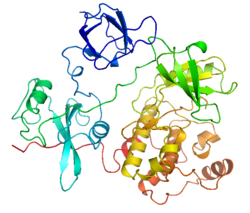Tyrosine kinase Src
| Tyrosine kinase Src | ||
|---|---|---|

|
||
| Ribbon model from c-Src according to PDB 1FMK | ||
| Properties of human protein | ||
| Mass / length primary structure | 536 AS ; 60 kDa | |
| Identifier | ||
| Gene names | SRC ; c-Src; SRC1; AVS | |
| External IDs | ||
| Enzyme classification | ||
| EC, category | 2.7.10.2 , tyrosine kinase | |
| Response type | Phosphorylation | |
| Substrate | Tyrosine | |
| Products | Phosphotyrosine | |
| Occurrence | ||
| Parent taxon | Vertebrates | |
| Orthologue | ||
| human | House mouse | |
| Entrez | 6714 | 20779 |
| Ensemble | ENSG00000197122 | ENSMUSG00000027646 |
| UniProt | P12931 | P05480 |
| Refseq (mRNA) | NM_005417 | NM_001025395 |
| Refseq (protein) | NP_005408 | NP_001020566 |
| Gene locus | Chr 20: 37.34 - 37.41 Mb | Chr 2: 157.42 - 157.47 Mb |
| PubMed search | 6714 |
20779
|
The tyrosine kinase Src (also c-Src: compound acronym from c ellular and s a rc oma ) is an endogenous protein from the family of tyrosine kinases that is present in the cytosol of the cell . c-Src is the gene product of the proto-oncogene SRC of the same name , ie a preliminary stage of a potentially cancer-causing gene product and is considered the best-studied proto-oncogene of all. c-Src was discovered in the 1970s by J. Michael Bishop , Harold E. Varmus and co-workers as the cell's own homolog of the oncogene v-Src of the Rous sarcoma virus . In doing so, they provided important insights into the development of cancer through misdirected endogenous triggers, for which they received the Nobel Prize in Physiology or Medicine in 1989 . c-Src was also the first representative of the tyrosine kinases to be identified.
c-Src is also the prototype of the kinases of the Src family, which also includes Lyn, Fyn, Lck, Hck, Fgr, Blk, Yrk and c-Yes.
biochemistry
structure
C-Src is a cytosolic protein that is associated with the cell membrane and is encoded by a gene on chromosome 20 gene locus q12-q13. c-Src consists of 4 so-called Src homology domains (SH1-4). The SH1 domain carries both the tyrosine groups essential for autophosphorylation and thus for the function of c-Src as well as the kinase function. The domains SH2 and SH3 contain binding sites for a phosphotyrosine residue contained in the C-terminus of c-Src or a polyproline structure close to the SH1 domain. SH2 and SH3 together with the C-terminus are responsible for the regulation of c-Src. The SH4 domain contains myristoylation sites and is therefore responsible for anchoring in the cell membrane. The first sequence of src was published in 1980 by Armin P. Czernilofsky et al. published and the tyrosine phosphorylation sites of v-src and c-src were 1981 by JE Smart and AP Czernilofsky et al. certainly.
Activation and regulation
The activity of c-Src is mainly regulated by phosphorylation and dephosphorylation of a tyrosine residue in the C-terminus (Y530). Phosphorylation of this tyrosine residue leads to a binding of the SH2 domain to the C-terminus and secondarily to a binding of SH3 to the kinase-bearing SH1 domain. By connecting SH3 to SH1, the kinase function is inhibited, so that c-Src is in an inactive state. Since the viral v-Src lacks the C-terminus including the tyrosine residue, which is essential for inactivation, it is in a permanently active (constitutively active) state.
The protein kinases CSK and CHK lead to an inactivation of c-Src via phosphorylation of the C-terminal tyrosine. In contrast, protein tyrosine phosphatases can activate c-Src via dephosphorylation of this tyrosine group. In addition, c-Src can independently of the phosphorylation state by competitive binding of interaction partners such. B. Fak and Cas , to the phosphotyrosine binding site of the SH2 domain or the polyproline binding site of the SH3 domain are activated. Activated receptor tyrosine kinases can also activate c-Src via this mechanism .
function
C-Src is a protein kinase that can activate numerous other proteins. The substrates of c-Src include in particular focal adhesion proteins , adapter proteins and transcription factors . Since important signal molecules, such as. B. Fak, Cas, Fish , Cortactin , p120 Catenin , RhoGAP , RRAS , JNK and STAT3 , are activated directly or indirectly by c-Src, c-Src plays a key role in intracellular signal transduction .
Src inhibitor
Src inhibitors are used in the therapy of tumors .
literature
- GS Martin: The hunting of the Src. In: Nature reviews. Molecular cell biology Volume 2, Number 6, June 2001, pp. 467-475. doi : 10.1038 / 35073094 . PMID 11389470 . (Review).
- A. Aleshin, RS Finn: SRC: a century of science brought to the clinic. In: Neoplasia. Volume 12, Number 8, August 2010, pp. 599-607, ISSN 1476-5586 . PMID 20689754 . PMC 2915404 (free full text).
- NA Chatzizacharias, GP Kouraklis, CT Giaginis, SE Theocharis: Clinical significance of Src expression and activity in human neoplasia. In: Histology and histopathology. Volume 27, Number 6, June 2012, pp. 677-692, ISSN 1699-5848 . PMID 22473690 .
Individual evidence
- ↑ Stehelin D., Varmus HE, Bishop JM, Vogt PK (1976). DNA related to the transforming gene (s) of avian sarcoma viruses is present in normal avian DNA. Nature 260: 170-173.
- ↑ Nature Vol 287, pp 198-203, 1980
- ^ Proc. Natl. Acad. Sci. USA , Vol. 78, pp 6013-6017, 1981)
- ^ Brown MT, Cooper JA (1996). Regulation, substrates and functions of src. Biochim. Biophys. Acta 1287: 121-149.
- ^ Courtneidge SA (2003). Isolation of novel Src substrates. Biochem. Soc. Trans. 31: 25-28.
Web links
- Jennifer McDowall / Interpro: Protein Of The Month: SRC, proto-oncogenic tyrosine-protein kinase. (engl.)